Introduction
Considering wildlife in your edible landscape can be a complex challenge. Although wild animals can cause crop damage, this may not be a conflict that has to be addressed. This publication provides a useful decision tree that helps users make choices regarding the species in their managed area. Our goal is to help the gardener become more accepting of wildlife among edible crops and coexist in a shared environment. This publication builds on the publication Edible Landscaping Using the Nine Florida-Friendly Landscaping™ Principles (https://edis.ifas.ufl.edu/publication/EP594). Specifically, we seek to provide a better understanding of Florida-Friendly Principle number 5, Attract Wildlife, as it relates to edible landscaping for the residential audience. Note that this publication does not cover insects, but primarily focuses on mammals, birds and reptiles. For more information on managing insects in your edible landscape, check out A Florida-Friendly Landscaping™ Approach to Pest Management in Your Edible Landscape (https://edis.ifas.ufl.edu/publication/EP629).
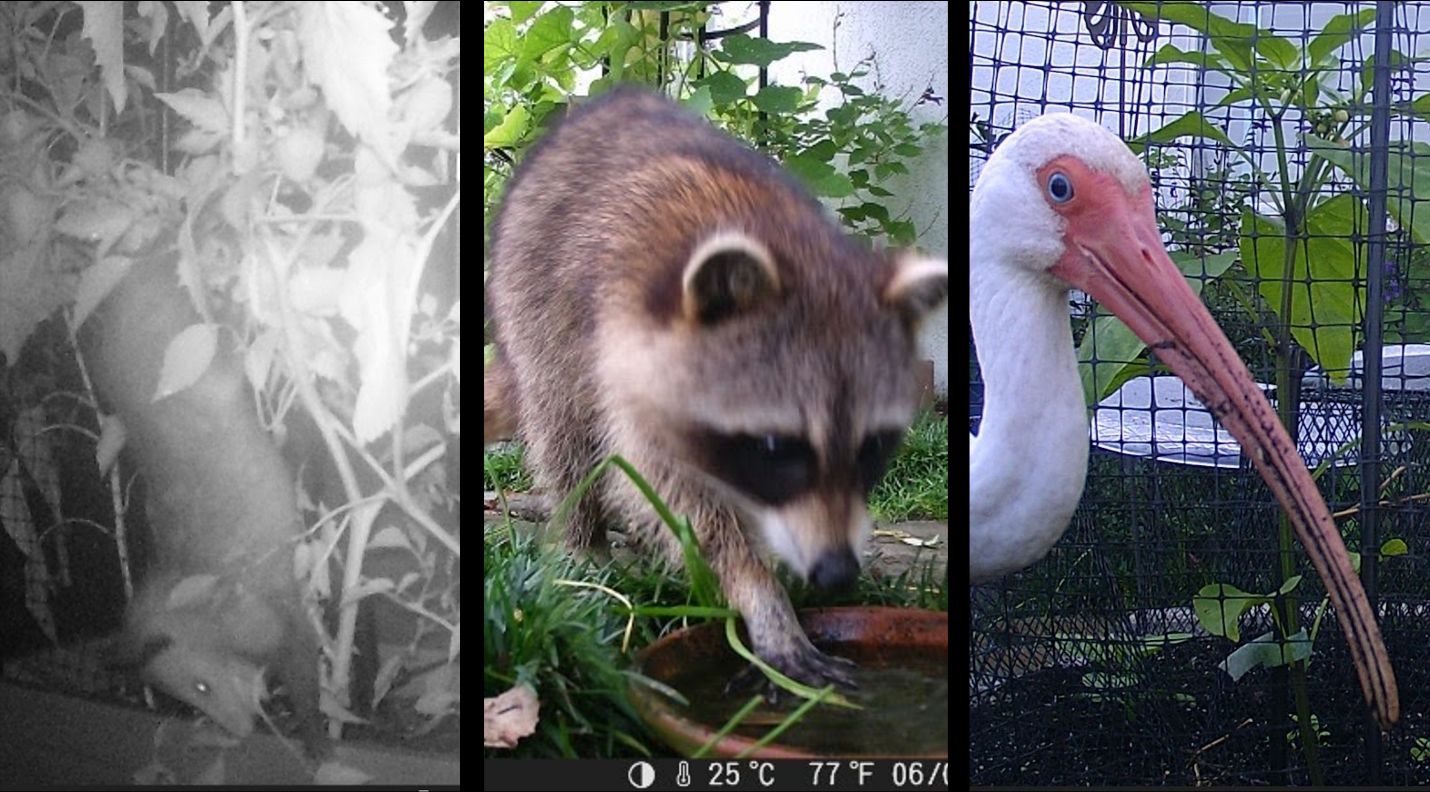
Credit: Mary Ann Pigora, Master Gardener Volunteer, UF/IFAS
There are many reasons to conserve wildlife. First, we safeguard the natural world and the many different animals within it for future generations. Second, humans need wildlife because they provide ecosystem services. Ecosystem services are benefits that humans receive from nature, such as food, clean air, recreational opportunities, nature-inspired ideas and spiritual connections. To learn more about ecosystem services and habitat connectivity, see Protecting Natural Areas during Development: Four Spatial Considerations to Maximize Their Benefits (https://edis.ifas.ufl.edu/publication/FR451).
For example, a yard with robust species diversity is more resilient to disease and outbreaks due to the presence and balance of natural predators, such as a hawk hunting a rat or a wasp predating a caterpillar. Many species also provide services such as recycling waste, pollinating crops, and regulating pest populations (Figure 5).
Reevaluating Landscape Goals
Florida is the third most populous state in the nation. As Florida’s population grows, humans and wildlife are more likely to interact. In 2020, nearly 1,000 people moved to Florida every single day (Miami Report 2020). With increased population and urban sprawl, wildlife is displaced from natural habitat (https://www.geoplan.ufl.edu/portfolio/fl-2070/). Research shows that urban environments can serve as wildlife refugia, if managed with wildlife in mind. Within the residential setting, it is possible to create landscapes where humans coexist with wildlife; however, this requires explicit goal setting.
To start this process, create a list of wildlife goals for your edible landscape. Although your goals likely include cultivating fruit, veggies, and herbs, as well as saving on your grocery bills and increasing food security, perhaps you can add some of the following:
- Learn about the wildlife in your area by doing research and recording your observations.
- Grow a diversity of flowers including various colors, bloom times and sizes.
- Support birds, bees, butterflies, and other pollinators by using Integrative Pest Management (IPM) strategies.
- Enhance biodiversity of ornamentals, annual crops, and trees by growing many different kinds of plants.
A great resource for selecting a diversity of flowers for pollinators with a variety of bloom times is Concepts for Sustainable Landscape Mosaics (https://edis.ifas.ufl.edu/publication/EP605).
Some wildlife are associated with crop and garden damage, such as deer and racoons. When creating these goals, consider your level of tolerance for damage from a particular species. Determining the threshold of damage you can tolerate is a personal choice driven by your individual gardening goals, aesthetics, and finances. The most important step to making decisions about wildlife management and defining your relationship to wildlife is identifying and understanding wildlife.
Rethinking “Nuisance” Wildlife
Start by asking what species of wildlife are present. To identify what species might be passing through or inhabiting the area, see How to Identify the Wildlife Species Responsible for Damage in Your Yard (https://edis.ifas.ufl.edu/publication/UW369). Once you have identified the animal, learn more about the species from credible academic or governmental institutions, such as the Florida Fish and Wildlife Conservation Commission. What are the cycles and life histories of the animal? When does it breed? Does it migrate? Are the populations declining? Misconceptions around animals are common reasons for fearing wildlife, and that fear can lead to a negative interaction. Being able to identify the species or simply letting the animal pass through will result in fewer negative interactions (https://myfwc.com/conservation/you-conserve/wildlife/). Once you better understand the animal, assess if it is damaging your crop, garden, or home, or if it is a threat to your family or neighbors (Figure 1). If wildlife is posing a threat to your home, refer to Dealing with Unwanted Wildlife in an Urban Environment (https://edis.ifas.ufl.edu/publication/UW070).
Every year snakes are killed by homeowners. Killing snakes increases your chances of being bitten and will not prevent other snakes from entering your yard. Killing nonvenomous snakes may be counterproductive, because some nonvenomous snakes actually eat venomous snakes; see Dealing with Snakes in Florida’s Residential Areas—Preventing Encounters (https://edis.ifas.ufl.edu/publication/UW260).
This is an example of why identification is important. Most Florida snakes are harmless and beneficial, and they remove extra rodent populations. Even venomous species are not particularly dangerous unless stepped on or provoked. Many people have a fear of snakes, but only six species out of 44 native Florida snakes are venomous. The six venomous snakes in Florida include the eastern coral snake, southern copperhead, cottonmouth, eastern diamondback rattlesnake, timber rattlesnake, and the dusky pygmy rattlesnake. For more information on identifying snakes in Florida, visit https://myfwc.com/conservation/you-conserve/wildlife/snakes/.
Other examples of wildlife in the edible Florida landscapes include:
- Wild boar
- Coyotes
- Deer
- Armadillos
- Opossums
- Squirrels
- Rabbits
- Birds
- Florida black bears (Figure 2)
- Iguanas
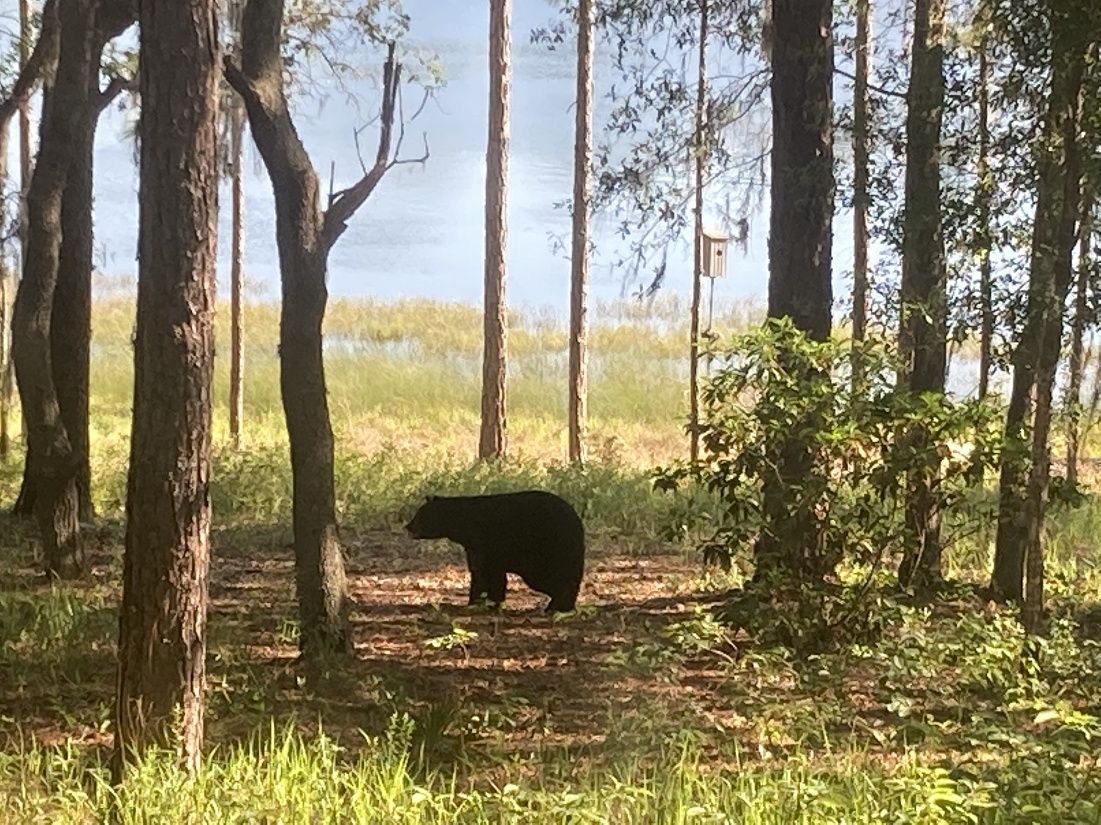
Credit: Tina McIntyre, UF/IFAS
Table 1. Examples of wildlife commonly found in edible landscapes and how they impact gardens and the environment.
Finding Solutions
Sometimes management is appropriate, especially when you consider the animal in the context of the food web. For example, if the animal in your yard is not harming your edible landscape but is invasive, removal is recommended. In urban areas in Florida, it is common to see invasive Cuban treefrogs. These may nestle in the leaves of your pineapple plant and do not cause direct damage to your edible landscape, but their feces can cause damage to the siding of your home, and they drastically reduce native amphibian populations. Thus, they should be removed. Utilize the decision tree (Figure 3) to help determine your course of action.
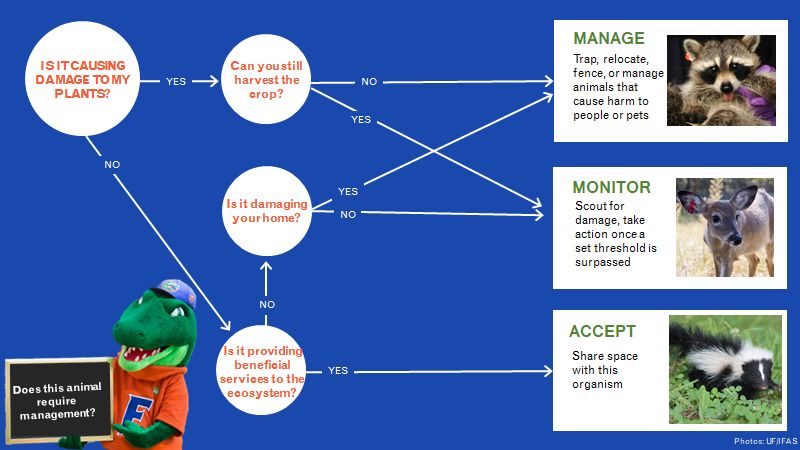
Credit: Tina McIntyre, UF/IFAS
Although wildlife diversity is critical for ecosystem functioning, if you cannot accommodate wildlife without comfortably compromising some of your garden harvest, you should address the problem. A good first step is to evaluate points of entry to your landscape. If there are no barriers and you are having problems with wildlife, consider placing a barrier that is permeable by some creatures, but not all. For example, deer fencing around a garden stops deer from nibbling on corn and other crops but still allows insects, birds, and other animals to pass. Consider allowing nesting birds or a small opossum family, which will leave when the season changes. Visit How to Use Deterrents to Stop Damage Caused by Nuisance Wildlife in Your Yard (https://edis.ifas.ufl.edu/publication/uw371) to address wildlife problems.
Here are some examples of ways you can manage and monitor wildlife in your edible landscape:
- Fence your garden area.
- Utilize binoculars and identification guides.
- Install a camera to monitor wildlife (Figure 1).
- Grow edibles in a grow box on the porch where animals can't get to it.
- Choose species that animals don’t like; for example, deer will eat sweet potatoes but not bananas.
- Cage your produce so the animals don’t eat it (Figure 4).
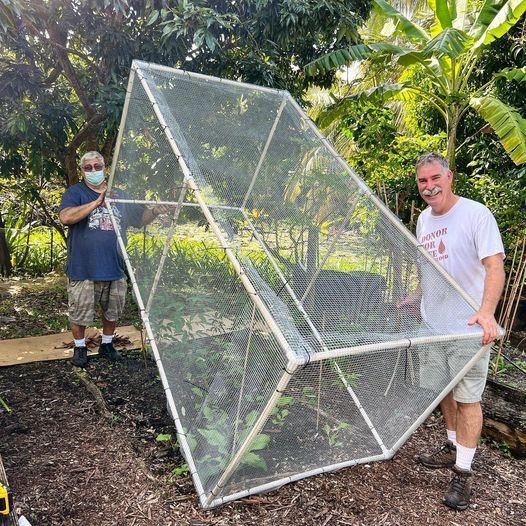
Credit: Gretchen Schmidt, Edible South Florida
For thousands of years, farmers have tried to find practical solutions for addressing animals consuming their crops. Mitigating loss of produce yield is important to be able to enjoy your efforts. However, Florida-Friendly Landscaping™ principle 5 is to Attract Wildlife, so we want to consider if the presence of this animal is an asset to the landscape or may cause harm prior to making the decision to eradicate. Some small animals, such as possums, squirrels, moles, armadillos and snakes, are important prey for top carnivores, such as our birds of prey. Most wildlife does not cause lasting damage to well-established perennials and add depth to your landscape, making it more analogous to a natural ecosystem. Native species inhabited the land prior to human development, and they now share our urban or suburban environments. It is important to reassess what is a nuisance/pest animal and the actual threats the animals may pose to humans in the urban-rural continuum. When animals enter your landscape or home, they are looking for food, water, cover (nesting, etc.), or space; components of habitat needed for their existence. Look for opportunities to create a biodiverse, resilient edible garden in your landscape so that these animals can be a part of it.
We would like to acknowledge Claire Lewis, Lyn Barber and Terra Freeman for their contributions to this publication.
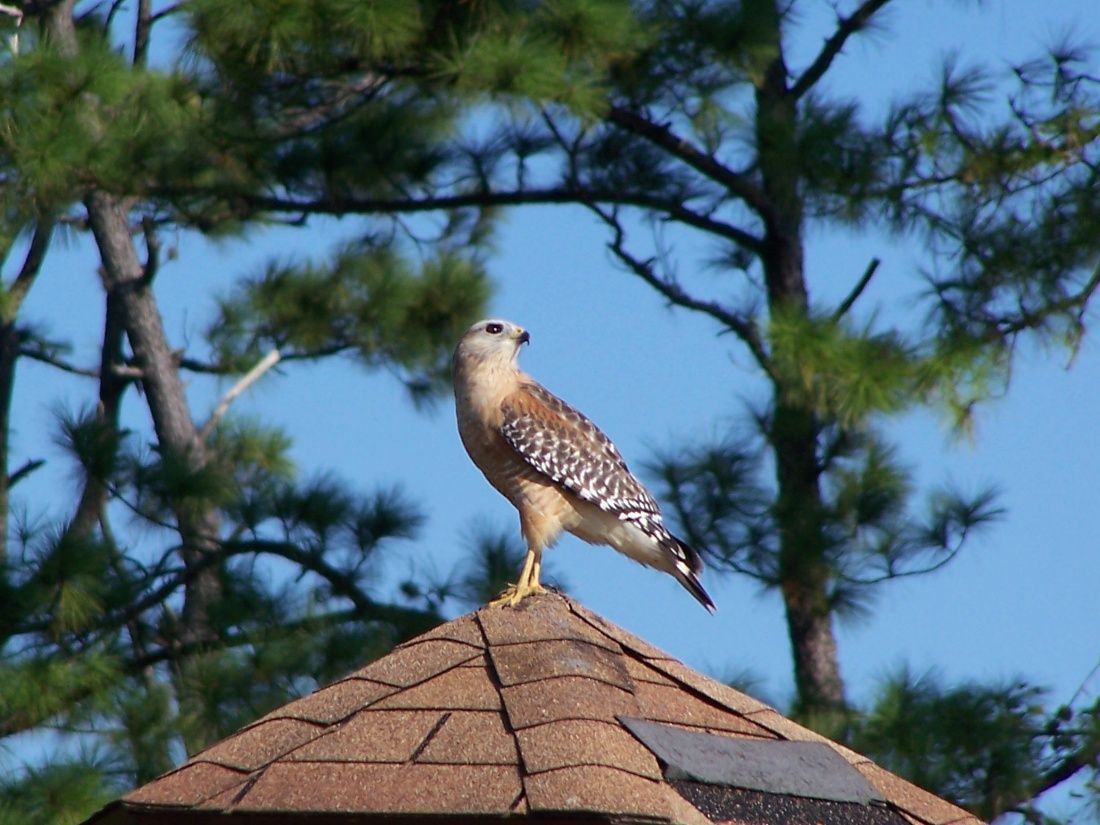
Credit: Tina McIntyre, UF/IFAS
References
Florida Fish and Wildlife Conservation Commission. n.d. “Living with Snakes.” https://myfwc.com/conservation/you-conserve/wildlife/snakes/
Frank, B., J. A. Glikman, and S. Marchini. 2019. Human-Wildlife Interactions: Turning Conflict into Coexistence. Cambridge University Press. https://doi.org/10.1017/9781108235730
Iannone III, B. V, T. McIntyre, A. J. Reisinger, E. Z. Bean, A. Tyrna, and B. L. Moffis. 2022. “Protecting Natural Areas during Development: Four Spatial Considerations to Maximize their Benefits.” EDIS 2022 (2). https://doi.org/10.32473/edis-fr451-2022
ISG World. 2020. Miami Report: Summer 2020 Edition. Issuu. https://issuu.com/isgworld/docs/isg_mr-2020-digital.1?fr=sZjE1NDIxMTMyNzg%5C
Johnson, S. A., and M. E. McGarrity. 2016. “Dealing with Snakes in Florida’s Residential Areas—Preventing Encounters.” EDIS 2007 (17). https://doi.org/10.32473/edis-uw260-2007
McIntyre, T., Gutner, R., Cohen, H., Silvasy, T., and Momol, E. 2023. “A Florida-Friendly Landscaping™ Approach to Pest Management in Your Edible Landscape.” EDIS 2023 (1). https://edis.ifas.ufl.edu/publication/EP629
Ober, H. K., and A. Kane. 2018. “How to Use Deterrents to Stop Damage Caused by Nuisance Wildlife in Your Yard.” EDIS 2012 (11). https://doi.org/10.32473/edis-uw371-2012
Ober, H. K., and A. Kane. 2022. “How to Identify the Wildlife Species Responsible for Damage in Your Yard.” EDIS 2012 (11). https://doi.org/10.32473/edis-uw369-2012
Ostfeld, R. S. 2017. “Biodiversity Loss and the Ecology of Infectious Disease.” The Lancet Planetary Health 1 (1): e2–e3. https://doi.org/10.1016/s2542-5196(17)30010-4
Schaefer, J. 2019. “Dealing with Unwanted Wildlife in an Urban Environment.” EDIS 1990 (12). https://edis.ifas.ufl.edu/publication/uw070
Silvasy, T., L. Barber, E. Momol, T. McIntyre, T. Wichman, G. Hansen, J. Marvin, T. Freeman, J. Sewards, W. Wilber, and J. Rivas. 2020. “Edible Landscaping Using the Nine Florida-Friendly Landscaping™ Principles.” EDIS 2020 (5). https://doi.org/10.32473/edis-ep594-2020